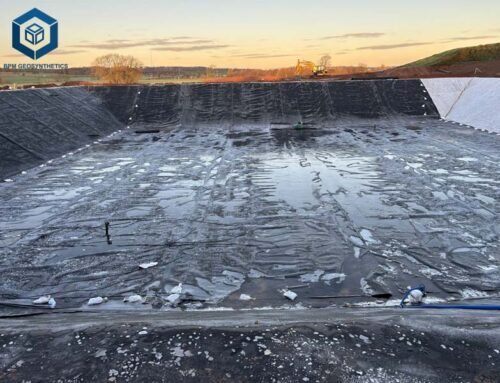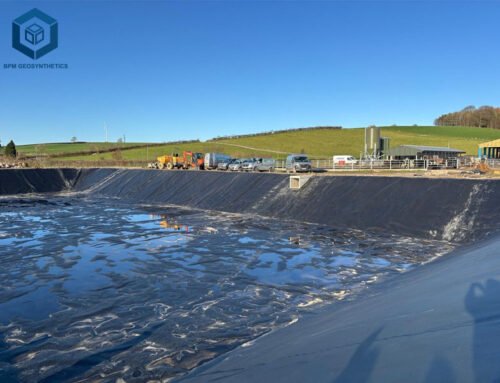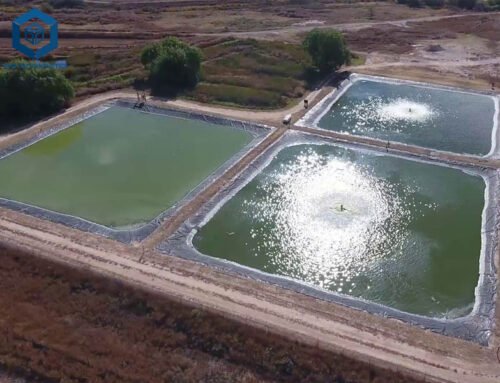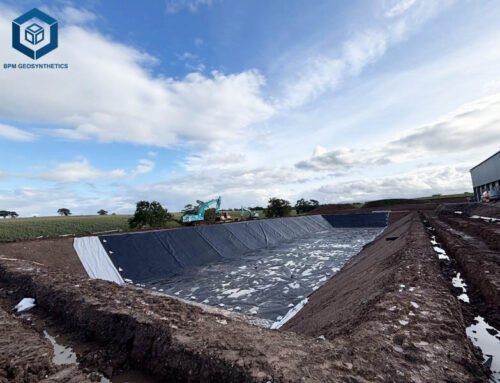Geomembranes are critical components in modern civil engineering, environmental protection, and industrial applications, serving as low-permeability barriers to prevent fluid and gas migration. With the global geomembrane market valued at $2.61 billion in 2025 and projected to grow at a 6.61% CAGR to $3.60 billion by 2030, demand is surging for sustainable, high-performance liners.
This blog post explores geomembrane prices, ranging from $0.20 to $3.50 per square foot ($2.15–$37.67/m²), with detailed insights into cost factors, specifications, and applications. Drawing on data from industry leaders like BPM Geosynthetics, Solmax, and Agru America, we provide actionable guidance for engineers, contractors, and project managers.
1. Understanding Geomembrane Price
Geomembrane prices vary significantly, from $0.20 per square foot ($2.15/m²) for thin LDPE liners to $3.50 per square foot ($37.67/m²) for thick, textured HDPE or composite liners. A typical 10,000-square-foot pond liner project, including materials and installation, costs $5,000–$25,000, while a 1-acre landfill liner can range from $87,120–$435,600. Key cost drivers include material type (40–50%), thickness and texture (10–20%), installation complexity (20–30%), and additional features (5–15%). This guide analyzes these factors with technical specifications to ensure informed budgeting for landfills, ponds, mining, and water management projects.
2. What is a Geomembrane?
Geomembranes are synthetic, impermeable liners used in geotechnical engineering to control fluid and gas migration. Made from polymers like high-density polyethylene (HDPE), linear low-density polyethylene (LLDPE), polyvinyl chloride (PVC), ethylene propylene diene monomer (EPDM), or polypropylene (PP), geomembranes offer tensile strengths of 20–80 kN/m (ASTM D6693), permeability rates below 1×10⁻¹² cm/s, and lifespans of 20–100 years. Their functions include containment, waterproofing, and environmental protection, with applications in:
- Landfills: Preventing leachate seepage with <0.1 mm permeability.
- Ponds and Aquaculture: Retaining water with 0.5–1.5 mm liners, reducing loss by 95%.
- Mining: Containing tailings and heap leach solutions with 1.5–2.0 mm HDPE.
- Water Management: Lining canals and reservoirs, saving 30% of water.
- Industrial Containment: Protecting soil from chemical spills with chemical-resistant PVC.
Geomembranes comply with ASTM D35, GRI-GM13/17, and ISO 9001 standards, offering a 10–20% lower carbon footprint than traditional barriers, driving a 7.6% CAGR through 2027.
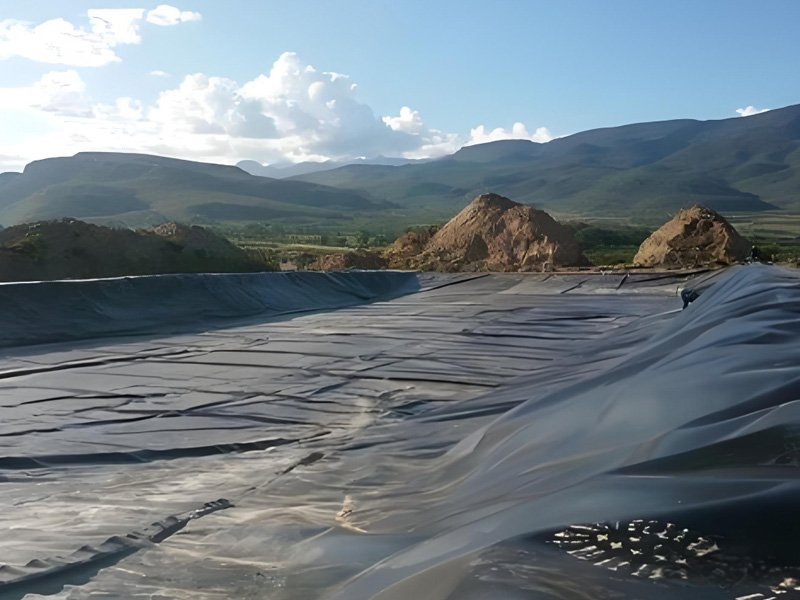
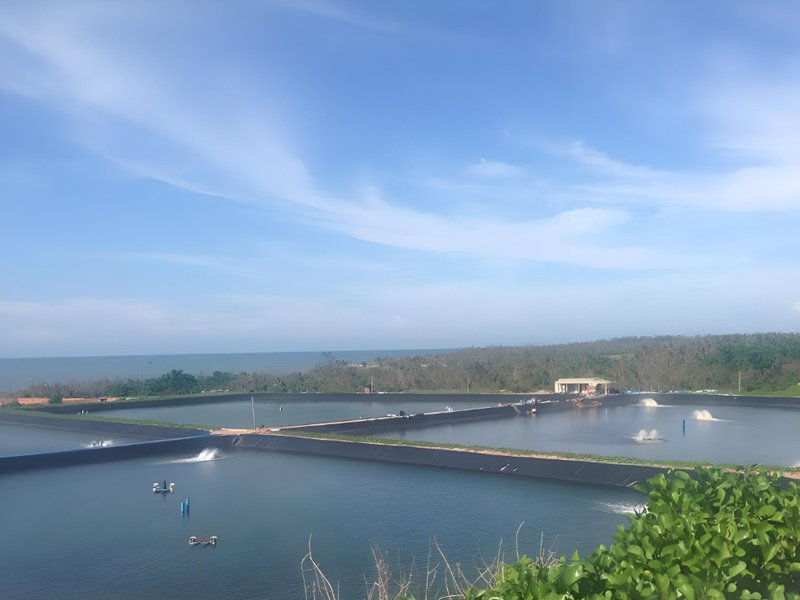
3. Key Factors Influencing Geomembrane Price
3.1 Material Type and Composition
High-Density Polyethylene (HDPE)
- Price: $0.30–$2.50/ft² ($3.23–$26.91/m²)
- Specifications: 0.5–3.0 mm thickness, 27–80 kN/m tensile strength, 1×10⁻¹³ cm/s permeability, 50–100-year lifespan
- Applications: Landfills, mining, water containment
- Pros: High chemical resistance, UV stability, weldable, 20% lower maintenance
- Cons: Less flexible, 10% higher installation cost
- Example: BPM’s 1.5 mm HDPE for a 10,000 ft² landfill costs $3,000–$25,000
Linear Low-Density Polyethylene (LLDPE)
- Price: $0.25–$1.50/ft² ($2.69–$16.15/m²)
- Specifications: 0.5–2.0 mm thickness, 20–50 kN/m tensile strength, 1×10⁻¹² cm/s permeability, 30–75-year lifespan
- Applications: Ponds, canals, secondary containment
- Pros: Flexible, low-temperature resistance, 15% easier installation
- Cons: Lower puncture resistance, 10% shorter lifespan
- Example: Solmax LLDPE for a 5,000 ft² pond costs $1,250–$7,500
Polyvinyl Chloride (PVC)
- Price: $0.20–$1.20/ft² ($2.15–$12.92/m²)
- Specifications: 0.5–2.0 mm thickness, 15–40 kN/m tensile strength, 1×10⁻¹¹ cm/s permeability, 20–50-year lifespan
- Applications: Aquaculture, decorative ponds, wastewater
- Pros: Cost-effective, flexible, 20% lower material cost
- Cons: UV-sensitive, 30% shorter lifespan
- Example: Agru PVC for a 2,000 ft² fish pond costs $400–$2,400
Ethylene Propylene Diene Monomer (EPDM)
- Price: $0.50–$2.00/ft² ($5.38–$21.53/m²)
- Specifications: 0.75–2.0 mm thickness, 10–30 kN/m tensile strength, 1×10⁻¹¹ cm/s permeability, 30–60-year lifespan
- Applications: Green roofs, ornamental ponds
- Pros: High elasticity, UV-resistant, 25% easier repairs
- Cons: Higher cost, limited chemical resistance
- Example: BPM EPDM for a 1,000 ft² rooftop costs $500–$2,000
Composite Geomembranes
- Price: $0.80–$3.50/ft² ($8.61–$37.67/m²)
- Specifications: HDPE/LLDPE with geotextile, 0.5–3.0 mm thickness, 30–100 kN/m tensile strength, 50–100-year lifespan
- Applications: Landfills, mining, high-risk containment
- Pros: Enhanced strength, puncture resistance, 30% higher durability
- Cons: Premium pricing, complex installation
- Example: BPM composite for a 20,000 ft² landfill costs $16,000–$70,000
Material Price Impact
HDPE, accounting for 60% of 2025’s geomembrane market, is ideal for high-durability applications, while LLDPE and PVC suit flexible, cost-sensitive projects. Polyethylene resin prices, at $1,300/MT in Q1 2025 (up 8%), influence costs by 30–40%.
3.2 Thickness and Texture
Thickness Range
Geomembranes range from 0.5–3.0 mm, with thicker liners costing 15–25% more. A 0.5 mm PVC costs $0.20–$0.50/ft², while a 2.0 mm HDPE costs $1.50–$2.50/ft². Thickness impacts application:
- 5–1.0 mm: Aquaculture, decorative ponds ($0.20–$1.00/ft²)
- 0–1.5 mm: Canals, wastewater ($0.50–$1.50/ft²)
- 5–3.0 mm: Landfills, mining ($1.00–$3.50/ft²)
Texture Options
- Smooth: $0.20–$2.00/ft², suited for flat surfaces, 10% cheaper
- Textured: $0.50–$3.50/ft², 30% higher friction angle for slopes, adds $0.10–$0.50/ft²
- Example: A 1.5 mm textured HDPE at $1.50/ft² costs $15,000 for 10,000 ft², versus $12,000 for smooth
Performance Benefits
Thicker liners (1.5–3.0 mm) offer 40% higher puncture resistance (1–2 kN, ASTM D4833) and last 50–100 years, compared to 20–50 years for 0.5 mm. Textured liners enhance slope stability by 30%, reducing slippage risks.
3.3 Roll Size and Project Dimensions
Standard Roll Sizes
Geomembranes are supplied in rolls with widths of 2–10 meters and lengths of 50–200 meters. A 6 m x 100 m roll covers 6,458 ft², costing $1,291–$16,145 at $0.20–$2.50/ft². Custom sizes add 5–10% ($0.01–$0.10/ft²) due to cutting and waste.
Project Size Impact
Larger projects benefit from economies of scale. A 50,000 ft² landfill at $1.50/ft² costs $75,000, with 20–30% savings on orders over 100,000 ft². A 1,000 ft² pond at $0.50/ft² costs $500, with minimal discounts.
Calculation Formula
To determine liner size:
- Area= (Length × Width) + 10–20% for overlaps
- Example: For a 100 ft x 50 ft pond:
- Area = 100 × 50 × 1.15 (15% overlap) = 5,750 ft²
- At $0.80/ft²: $4,600
Shipping Costs
Rolls weigh 100–1,000 kg, with shipping at $0.02–$0.15/ft². Lightweight LLDPE (0.5–1.0 mm) reduces shipping by 20% compared to HDPE (1.5–3.0 mm). BPM’s compact rolls cut logistics costs by 15%.
3.4 Installation Requirements
Labor Costs
Installation accounts for 20–30% of costs, ranging from $0.30–$2.00/ft². Simple pond liners cost $0.30–$0.80/ft², while landfill liners require skilled welding ($1.00–$2.00/ft²). A 10,000 ft² installation at $1.50/ft² adds $15,000.
Site Preparation
Site clearing, grading, and compaction cost $0.10–$0.50/ft². Soft soils require deeper excavation (6–12 inches) and geotextile underlays ($0.30–$1.00/ft²), increasing costs by 20%. A 1-acre soft subgrade adds $8,712–$43,560.
Welding and Seaming
Welding (hot-wedge or extrusion) ensures watertight seams, costing $0.05–$0.20/ft². Textured liners require 10% more welding time. Poor seaming risks $5,000–$20,000 in repairs for a 50,000 ft² project.
3.5 Additional Features
UV Resistance
UV stabilizers, standard in HDPE and LLDPE, add $0.02–$0.05/ft² but ensure 50–100-year lifespans. Non-UV-resistant PVC degrades 40% faster, increasing replacement costs by 20%.
Chemical Resistance
HDPE and PVC resist acids, alkalis, and hydrocarbons, adding $0.05–$0.15/ft². Essential for mining, this reduces degradation risks by 95%.
Textured Surfaces
Textured liners for slopes add $0.10–$0.50/ft², improving friction by 30% and stability by 20%.
Composite Layers
Geotextile-bonded composites add $0.30–$1.00/ft², enhancing puncture resistance by 50% and tensile strength by 30%.
3.6 Manufacturing and Supply Chain
Raw Material Costs
Polyethylene resin prices reached $1,300/MT in Q1 2025, up 8% from Q4 2024, impacting costs by 30%. A 1.0 mm HDPE uses $0.03–$0.05/ft² in resin, with additives adding $0.01–$0.02/ft².
Production Processes
Extrusion for smooth liners ($0.20–$2.00/ft²) is 15% cheaper than calendaring for textured liners ($0.50–$3.50/ft²). BPM’s automated lines ensure 99% defect-free rates, adding $0.05–$0.10/ft² for quality control.
Supplier Location
Chinese manufacturers like BPM offer 15–20% lower prices ($0.20–$2.50/ft²) than U.S. or European suppliers ($0.50–$3.50/ft²) due to labor rates ($2–$5/hour vs. $15–$25/hour). U.S. suppliers reduce delivery times by 50%.
3.7 Order Quantity and Customization
Bulk Discounts
Orders over 50,000 ft² save 20–30%. A 1.0 mm HDPE at $0.80/ft² drops to $0.56/ft² for 100,000 ft², saving $24,000 on a 1-acre project.
Custom Fabrication
Custom thicknesses, colors, or roll sizes add 5–10% ($0.01–$0.10/ft²). BPM’s 10-meter-wide rolls reduce seams by 15%, minimizing leakage risks.
3.8 Maintenance and Lifespan
Maintenance Costs
Geomembranes require minimal maintenance ($0.01–$0.05/ft² annually), saving 30–50% compared to concrete ($0.10–$0.20/ft²). A 10,000 ft² landfill costs $100–$500/year to maintain.
Lifespan Benefits
HDPE liners last 50–100 years, with composites offering 30% longer durability than PVC. A $15,000 HDPE landfill over 50 years costs $0.03/ft² annually, versus $0.10/ft² for concrete over 20 years.
4. Price Ranges by Geomembrane Application
4.1 Landfill Liners
- Price Range: $0.80–$3.50/ft² ($8.61–$37.67/m²)
- Examples: BPM 1.5 mm HDPE ($0.80–$2.50), Solmax Composite ($1.50–$3.50)
- Specifications: 1.5–3.0 mm, 27–80 kN/m tensile strength, 50–100-year lifespan
- Use Case: Waste containment (50,000–500,000 ft²)
- Cost Drivers: Thick HDPE ($0.80–$2.50/ft²), skilled welding ($1.00–$2.00/ft²)
4.2 Pond and Aquaculture Liners
- Price Range: $0.20–$1.50/ft² ($2.15–$16.15/m²)
- Examples: BPM 0.5 mm PVC ($0.20–$0.80), LLDPE 1.0 mm ($0.50–$1.50)
- Specifications: 0.5–1.5 mm, 15–50 kN/m tensile strength, 20–75-year lifespan
- Use Case: Fish ponds, reservoirs (1,000–50,000 ft²)
- Cost Drivers: Thin PVC ($0.20–$0.80/ft²), flexible LLDPE ($0.50–$1.50/ft²)
4.3 Mining Liners
- Price Range: $0.80–$3.00/ft² ($8.61–$32.29/m²)
- Examples: BPM 2.0 mm HDPE ($1.00–$2.50), Agru Textured ($1.50–$3.00)
- Specifications: 1.5–3.0 mm, 27–80 kN/m tensile strength, 50–100-year lifespan
- Use Case: Tailings, heap leach pads (100,000–1,000,000 ft²)
- Cost Drivers: Chemical-resistant HDPE ($1.00–$2.50/ft²), textured surfaces ($0.10–$0.50/ft²)
4.4 Water Management
- Price Range: $0.25–$1.50/ft² ($2.69–$16.15/m²)
- Examples: BPM 1.0 mm LLDPE ($0.50–$1.50), PVC 0.75 mm ($0.25–$1.00)
- Specifications: 0.5–1.5 mm, 15–50 kN/m tensile strength, 20–75-year lifespan
- Use Case: Canals, reservoirs (10,000–100,000 ft²)
- Cost Drivers: Flexible LLDPE ($0.50–$1.50/ft²), minimal seaming ($0.05–$0.20/ft²)
4.5 Industrial Containment
- Price Range: $0.50–$2.50/ft² ($5.38–$26.91/m²)
- Examples: BPM 1.5 mm PVC ($0.50–$1.50), HDPE Composite ($1.50–$2.50)
- Specifications: 1.0–2.0 mm, 20–80 kN/m tensile strength, 20–100-year lifespan
- Use Case: Chemical storage, wastewater (5,000–50,000 ft²)
Cost Drivers: Chemical resistance ($0.05–$0.15/ft²), composite layers ($0.30–$1.00/ft²)
5. Price Breakdown Example: BPM 1.5 mm HDPE Geomembrane
For a 10,000-square-foot landfill liner using BPM’s 1.5 mm HDPE geomembrane, retailing at $0.80–$2.50/ft² (MOQ 10,000 m²):
- Materials (40%): $8,000–$25,000
- HDPE resin: $4,800–$15,000
- Carbon black, UV stabilizers: $1,600–$5,000
- GRI-GM13 quality control: $1,600–$5,000
- Installation (30%): $3,000–$15,000
- Labor: $2,000–$10,000
- Site preparation: $1,000–$5,000
- Shipping (10%): $200–$1,500
- Container shipping: $200–$1,500
- Additional Features (10%): $800–$2,500
- Textured surface: $400–$1,500
- Chemical resistance: $400–$1,000
- Profit Margin (10%): $800–$2,500
- Total Price: $12,800–$46,500 ($1.28–$4.65/ft²)
This geomembrane offers 27 kN/m tensile strength, 1×10⁻¹³ cm/s permeability, and a 50-year lifespan, ideal for landfill containment.

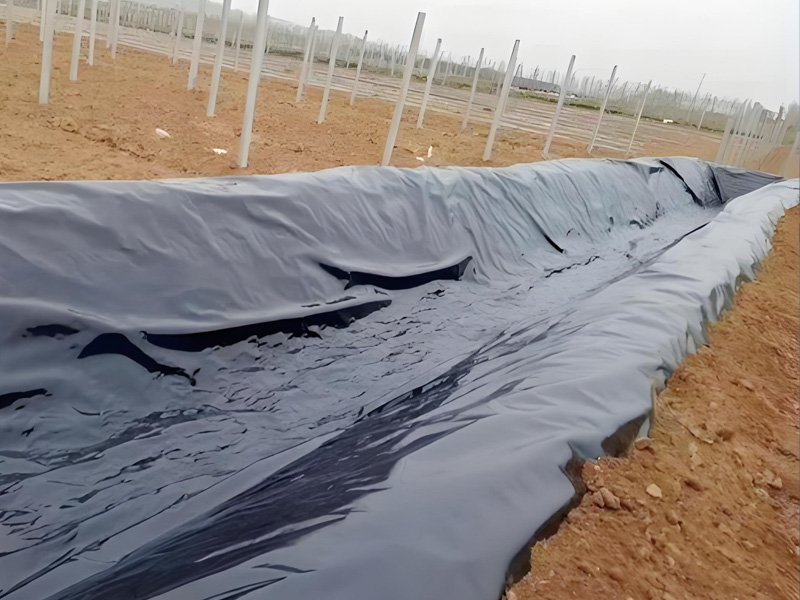
6. Budgeting Tips for Geomembrane Projects
6.1 Match Liner to Application
- Must-Haves: Permeability <1×10⁻¹² cm/s, 20–80 kN/m tensile strength, 20+ year lifespan.
- Optional: Textured HDPE for slopes ($0.80–$3.50/ft²), PVC for ponds ($0.20–$1.20/ft²).
- Savings: Use LLDPE ($0.25–$1.50/ft²) for canals, reserving HDPE for landfills.
6.2 Leverage Bulk Discounts
Order 50,000+ ft² to save 20–30%. Contact BPM Geosynthetics for volume pricing on large projects.
6.3 Optimize Installation
Hire certified welders for seams ($0.05–$0.20/ft²) to reduce leaks by 95%. Schedule in dry weather to save 10–15% on delays.
6.4 Invest in Longevity
Choose 1.5–3.0 mm liners ($0.80–$3.50/ft²) for 50–100 years, saving 40% on replacements compared to 0.5 mm over 20 years.
6.5 Use Protective Layers
Add geotextiles ($0.30–$1.00/ft²) to prevent punctures, extending lifespan by 30%.
6.6 Plan for Maintenance
Budget $0.01–$0.05/ft² annually for inspections to avoid $5,000–$20,000 in repairs.
7. Recent Trends in Geomembrane Applications
7.1 Sustainable Materials
Recycled polyethylene, used in 10% of 2025 projects, saves 10–15% ($0.02–$0.05/ft²) and reduces emissions by 10%. Bituminous geomembranes (BGMs) gained 5% market share in landfills, offering 20% higher puncture resistance.
7.2 Smart Geomembranes
Sensor-embedded liners, adopted in 2% of 2025 mining projects, add $0.10–$0.30/ft² but monitor leaks, reducing repair costs by 25%.
7.3 Infrastructure Investments
Global infrastructure spending, projected at $15.5 trillion by 2030, drives geomembrane use in canals and landfills. Asia-Pacific, with 50% market share, leads demand due to China and India’s urbanization.
7.4 Modular Liners
Prefabricated panels, used in 5% of 2025 pond projects, reduce installation by 20% ($0.05–$0.20/ft²). BPM’s 10-meter-wide rolls cut seams by 15%, enhancing efficiency.
8. FAQs
What is the average price of geomembranes?
Geomembranes cost $0.20–$3.50/ft², with typical projects at $0.80–$2.50/ft². A 10,000 ft² landfill liner costs $12,800–$46,500.
Why choose geomembranes over traditional liners?
Geomembranes offer 95% lower permeability, 50–100-year lifespans, and 30% lower maintenance, outperforming concrete or clay.
Are thin geomembranes cost-effective?
Yes, 0.5–1.0 mm PVC ($0.20–$1.00/ft²) suits ponds, but 1.5–3.0 mm HDPE ($0.80–$3.50/ft²) is better for landfills.
Can I get custom geomembranes?
BPM offers custom thicknesses (0.5–3.0 mm) and roll sizes (2–10 m) with MOQs of 10,000 m², adding 5–10% to prices.
How do I budget for a geomembrane project?
Prioritize permeability (<1×10⁻¹² cm/s), tensile strength (20–80 kN/m), and 20+ year lifespan. Use LLDPE for ponds, HDPE for high-risk containment.
9. Final Thoughts
Geomembrane prices range from $0.20 to $3.50 per square foot, driven by material type (40–50%), thickness and texture (10–20%), installation (20–30%), and features (5–15%). HDPE ($0.80–$3.50/ft²) excels in landfills, while PVC ($0.20–$1.20/ft²) suits ponds. By understanding cost drivers—resin prices, welding, and UV resistance—project managers can optimize budgets. BPM Geosynthetics, with 17+ years of expertise and a 99% defect-free rate, delivers cost-effective, high-performance liners.
Please contact BPM Geomembane for samples and quotes at best factory price to ensure a durable, sustainable project.


